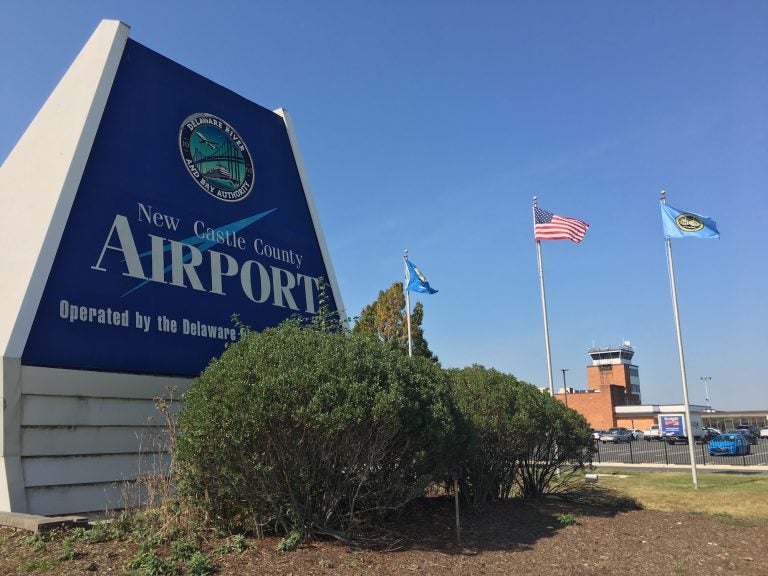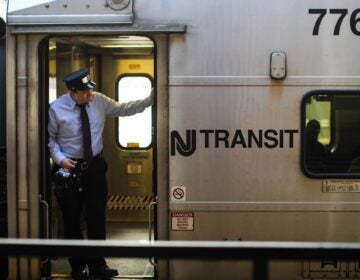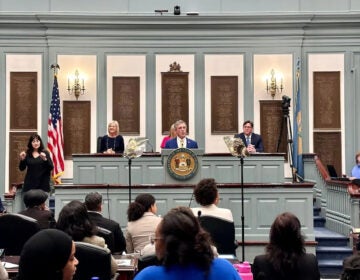How could Wilmington Airport really take off? Flying more packages than passengers
Attempts to add passenger flights out of Wilmington have fizzled. So New Castle County wants to explore different uses to make the airport more profitable.
Listen 0:47
A task force will explore new uses for the Wilmington Airport, formerly called the New Castle County Airport as seen on the sign out front. (Mark Eichmann/WHYY)
Travelers in Delaware have seen passenger air service come and go at the airport just south of Wilmington. Frontier Airlines was the most recent company to start and then stop commercial flights from Delaware in 2015, just two years after they started.
Now, local leaders are searching for a different way. New Castle County Executive Matt Meyer is creating a task force to explore how the airport can better serve the local economy. He said the airport is the most valuable property the county owns.
“It’s really one of the most valuable pieces of real estate in the state,” Meyer said. “We are going to take a hard look at this airport … to make sure that this facility is used for the benefit of the people of New Castle County.”
A 2018 economic impact study commissioned by DelDOT found the airport provides direct employment for more than 1,600 workers and generates $10 million in state and local tax funds. Meyer wants to get even more value out of the facility and is looking at the possibility of changing the airport’s operations agreement.
In 1995, the county signed a 30-year lease with the Delaware River and Bay Authority, handing control of the airport to the bi-state agency that operates the Delaware Memorial Bridge, the Cape May-Lewes Ferry, and other facilities. Under that agreement, the county has until 2020 to inform DRBA if the deal will be extended, modified, or terminated.
Meyer wasn’t critical of DRBA’s operation of the airport, but he said the county wants to explore other options.
“Whether DRBA could have done better, who knows? I’m not sure that’s too relevant to us,” Meyer said. “The goal is to look to the present and look forward.”
DRBA spokesman Jim Salmon issued a statement Wednesday afternoon saying the DRBA “has the same goal as New Castle County Executive Matt Meyer — to stimulate job creation and economic growth at the New Castle-Wilmington Airport.”
When it gained control in 1995, the DRBA took over about $7 million in airport-related debt. DRBA has also compensated the county’s Economic Development Corp. $250,000, delivered in monthly payments over a 30-month period, Salmon said. The DRBA spent $139 million on capital improvements, including a new state-of-the-art airport traffic control tower, 10 new corporate hangars, and a new $5.1 million paint hangar for Dassault-Falcon Jet.
The Wilmington Airport’s main disadvantage, especially in trying to establish passenger air service, is its close proximity to Philadelphia International Airport, which is about 25 miles away. Meyers pointed to smaller airports around the country that are similarly located near a big international airport but have found a niche use other than passenger service. He used as an example Piedmont Triad Airport near Greensboro, North Carolina, which has become home to Honda Aircraft’s manufacturing and warehouse facility.
“They’re in the shadows of the Raleigh-Durham International Airport, so … they’ve looked at avionics training, at airport mechanics, and things of that sort,” Meyer said.
The comparison between Piedmont and Wilmington falls apart a bit when looking at the numbers. More than 2 million passengers flew out of Piedmont Triad in the past year, according to the U.S. Department of Transportation’s Bureau of Transportation Statistics. And while that number is dwarfed by the 12 million people that fly out of Raleigh-Durham, it is 2 million more than flew out of Wilmington last year. Piedmont is also about 90 miles away from Raleigh, more than three times the distance between the airports in Wilmington and Philadelphia.
Another option besides passenger travel could be establishing the Wilmington Airport as a hub for e-commerce logistics, moving freight and packages around the region and beyond by air.
“If you look at the location and the cost, this could really be potentially a major logistics hub for the economy of today and tomorrow,” Meyer said.
Ships unloading hundreds of tons of cargo at the nearby Port of Wilmington could also fuel the airport’s future as a logistics hub. Former state economic development director Alan Levin, who will lead the task force, said the port could also serve as an example of a new lease partner that could take over operations at the airport.
“The truth is, New Castle County and DRBA are not the best operators of that facility,” Levin said. He pointed to the 50-year lease the state signed with UAE-based Gulftainer to run the Port of Wilmington in 2018 as a model for what could happen at the airport.
“We found operators to run a port — and in this case, to run an airport is what we should do, somebody who does this on a day-in, day-out basis,” Levin said. “Matt may be a very good county executive and County Council may be very good at what they do, but they don’t run airports, and that’s what we need.”
As part of the lease, Gulftainer pledged to invest hundreds of millions in upgrading the port and is paying the state a $6 million royalty payment that is expected to rise to $13 million by 2027.
The task force is made up of industry experts and local business leaders. They’re expected to deliver their recommendations by April 2020. The county must notify DRBA of its decision on renewing the lease by June 30, 2020.
WHYY is your source for fact-based, in-depth journalism and information. As a nonprofit organization, we rely on financial support from readers like you. Please give today.





